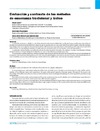Please use this identifier to cite or link to this item:
https://accedacris.ulpgc.es/jspui/handle/10553/56567
| Title: | Evaluación y contraste de los métodos de enseñanza tradicional y lúdico | Other Titles: | Evaluation and contrasts of the methods of traditional and playful education | Authors: | Bovi, Fabio Palomino, A. González Henríquez, Juan José |
UNESCO Clasification: | 5801 Teoría y métodos educativos | Keywords: | Natación Metodología Lúdico Sistémico Aprendizaje, et al |
Issue Date: | 2008 | Journal: | Apunts. Educacion Fisica y Deportes | Abstract: | La natación, como ya es sabido, es uno de los deportes más recomendados hoy en día, por lo que resulta muy interesante su estudio y la comprensión de los diferentes aspectos que le caracterizan, con particular referencia a determinados intervalos de edad. Este trabajo tiene como objetivo el conocimiento de las diferencias que se producen entre la enseñanza de la natación a través de la utilización de una metodología sistémica o tradicional, y la enseñanza de la misma llevada a cabo de forma lúdica. La razón que nos ha llevado a la realización de este estudio, ha sido la intención, de averiguar si ambas metodologías influyen de igual manera en el aprendizaje de la natación, o si una es más efectiva y completa que otra. Para responder a nuestra hipótesis, hemos analizado todos los aspectos considerados de especial relevancia en el aprendizaje de la natación, sobre todo los relacionados con los intervalos de edad elegidos para nuestro estudio (3-8 años), obteniendo finalmente unos resultados que nos han confirmado que existen diferencias significativas, entre las dos estrategias utilizadas. As everybody knows, swimming is today one of the most advisable sports, thereby is very interesting its study, and the understanding of the different topics that characterize this sport, with special regard to fixed age ranges. The goal of this study is the knowledge of the differences that arise between the traditional-classic teaching methodology of swimming and the playful teaching methodology. The reason that led us to the implementation of this study was the necessity to verify whether both methodologies impact the same on learning to swim, and, if not, which one is more effective and complete. In order to give an answer to our hypothesis, we have analyzed all kind of aspects that could produce an impact on the learning ofswimming, above all the onesrelated to the chosen age ranges(3 to 8 years). The results confirmed usthat important differences exist between the two methodologies. |
URI: | https://accedacris.ulpgc.es/handle/10553/56567 | ISSN: | 1577-4015 | Source: | Apunts: Educación física y deportes [ISSN 1577-4015], vol. 4 (94), p. 29-36 | URL: | http://dialnet.unirioja.es/servlet/articulo?codigo=2987668 |
| Appears in Collections: | Artículos |
Items in accedaCRIS are protected by copyright, with all rights reserved, unless otherwise indicated.
